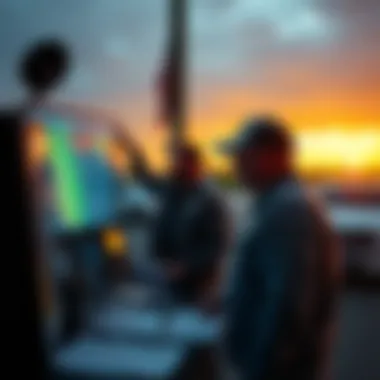Understanding Weather Radar in the Florida Panhandle


Intro
The Florida Panhandle is a unique stretch of land, rich in natural beauty, outdoor activities, and climatic nuances. Amidst its picturesque beaches and vibrant bayous lies a technological ally that plays a vital role in ensuring safety and enjoyment: weather radar systems. In this region, where sudden thunderstorms can spring up as quickly as a pop-up tent, understanding these radar systems is not just beneficial; it’s essential.
By delving into the intricacies of weather radar, this article aims to clarify how these systems work, their significance for local weather prediction, and their impact on activities like kiteboarding—an increasingly popular pastime among both novices and seasoned adventurers. Whether you’re checking the weather before heading out for a ride or planning a trip to enjoy the outdoors, grasping the fundamentals of weather radar can enhance your experience and provide peace of mind.
From examining the technology that powers these radar systems to discussing the role of local meteorological services, this comprehensive overview will equip you with insights critical for understanding weather dynamics along the Gulf Coast. It’s a journey that connects technology, environmental science, and recreational pursuits, uniting enthusiasts and professionals alike.
Gear and Equipment
When kiteboarding in the Florida Panhandle, knowing how to navigate the skies is just as crucial as the gear you choose to use. The right equipment not only ensures a smoother ride but also significantly affects safety and performance.
Essential Kiteboarding Gear for Beginners
A beginner's journey into kiteboarding can seem daunting, but with the right tools, it becomes a rewarding adventure. Here are a few essentials:
- Kite: This is the heart of your setup. For beginners, a stable, larger kite is recommended for more lift and easier control. Brands like Cabrinha and Naish have superb entry-level options.
- Board: A beginner-friendly board should be wide and buoyant for easy upwind progress. The Slingshot Misfit is noted for its balance between speed and stability.
- Harness: Opt for a comfortable and well-padded harness. A hook-and-loop design is easy to adjust, providing better support during those early learning sessions.
- Safety Gear: A helmet and impact vest will go a long way in protecting you from bumps and bruises.
Advanced Equipment for Experienced Riders
Once you've mastered the basics, it’s time to elevate your experience.
- Performance Kite: Experienced kiteboarders often choose a smaller, more maneuverable kite for tricks and speed. The Ozone Edge is well-regarded among pro riders.
- Specialized Board: Advanced boards vary based on style and preference—freestyle, wave riding, or racing. A high-performing board like the Duotone Gonzales could push your limits higher.
- Control Bar: Upgrading to a more responsive control bar can enhance handling. Look for features like adjustable length or specific safety systems.
With the right equipment in your corner and an understanding of how weather conditions affect your ride, you're setting the stage for unforgettable experiences along the sunny shores of the Florida Panhandle.
Preamble to Weather Radar
Weather radar has become a cornerstone in understanding and forecasting atmospheric conditions. For those living in or visiting the Florida Panhandle, grasping how these systems operate can significantly enhance one’s ability to engage with the region's dynamic weather. Notably, this area is susceptible to sudden thunderstorms and tropical storms, making radar information invaluable.
Weather radar provides real-time data that offers insight into not just precipitation, but also storm structure and movement. This means, whether you’re organizing a family beach outing or planning a kiteboarding session, knowing when the skies might unleash their fury can alter your plans effectively. Moreover, a deeper comprehension of how weather radar works can lead to better decision-making, whether you are an outdoor enthusiast or simply aiming to avoid a deluge.
There are several crucial benefits tied to the use of weather radar in this landscape:
- Timeliness: Weather radar provides instant updates, which is indispensable for making last-minute decisions regarding outdoor activities.
- Precision: Unlike general forecasts, radar systems can pinpoint specific areas that might be experiencing rain or thunderstorms. This granularity can mean the difference between getting caught in a downpour or enjoying a sunny day.
- Preparedness: With increasing instances of volatile weather, radar technology equips individuals and service providers with the tools to prepare adequately—be it for a day at the beach or a kiteboarding adventure on open waters.
Navigating the complexities of weather radar not only aids the casual observer but enriches the experience of professionals as well, as it integrates seamlessly into various activities conducted in the Florida Panhandle’s diverse environmental tapestry.
What is Weather Radar?
Weather radar is a specialized technology that transmits radio waves and analyzes their reflections from precipitation particles in the atmosphere. This feedback allows meteorologists to determine precipitation intensity, type (rain, snow, hail), and even movement direction. Unlike traditional forecasting methods that utilize weather models, radar provides crucial real-time insights.
Typically, a radar system consists of a radar dish, which emits pulses of electromagnetic waves. When these waves hit precipitation or other atmospheric phenomena, they scatter in various directions. Some of these scattered waves return to the radar system, providing the necessary data for analysis. The data gets processed and visualized, producing what you usually see on weather forecasts.
Furthermore, radar systems can operate in different modes, offering flexibility in covering various weather phenomena—from light rain showers to severe weather events. Notably, Doppler radar can detect movement, which allows it to gauge wind speed and direction, essential for storm tracking.
Importance in Meteorology
In the field of meteorology, the importance of weather radar cannot be overstated. For one, its ability to deliver updates quickly is crucial, especially during severe weather conditions, which may unfold rapidly, particularly in the Florida Panhandle. Here, the weather can shift from calm to tempestuous in the blink of an eye.
Additionally, radar data is instrumental in warning systems. It helps authorities and meteorologists issue alerts and advisories when conditions threaten life or property. This aspect is critical because advanced warning can be the line between safety and disaster.
Beyond immediate safety benefits, radar also contributes to longer-term climatology efforts. By collecting incremental data over time, it assists in understanding climate trends and patterns, which are increasingly vital given the impacts of climate change.
"Weather radar is not just about predicting the rain; it’s about understanding the dance of the elements and how they interact within our atmosphere."
Ultimately, the integration of weather radar technology stands as a pivotal force in advancing meteorological science and improving daily lives in the Florida Panhandle.
Overview of the Florida Panhandle


Understanding the Florida Panhandle is crucial to grasping the complexities of its weather patterns and the role of radar in forecasting. This region, often referred to as the "forgotten coast," is characterized by its rich geographical diversity and distinct climatic conditions. These elements not only shape the everyday life of its residents but also significantly impact outdoor activities, such as kiteboarding, which draws enthusiasts from near and far.
The geographical features of the Panhandle include stunning coastlines, lush forests, and rolling hills. This mix creates a unique environment that can both enhance and challenge weather predictions. Likewise, the climatic conditions here are influenced by a combination of coastal and inland air masses. Understanding these features allows meteorologists to better interpret radar data, leading to more accurate weather forecasts.
Geographical Features
The Florida Panhandle is an area steeped in natural beauty and varied topography. The coastline stretches along the Gulf of Mexico, offering picturesque beaches that are a magnet for both locals and tourists. In comparison with the rest of Florida, the Panhandle possesses a notably diverse landscape. Here, sandy beaches gently transition into dense pine forests and wetlands dotted with wildlife.
- Coastline: The extensive shoreline features unique ecosystems that can affect weather systems. For example, local sea breezes can lead to sudden changes in temperature and precipitation patterns.
- Elevation: The region isn’t completely flat; it boasts elevated terrains that can influence wind patterns and storm development. Areas with higher elevations can sometimes experience different weather conditions compared to the coastal regions.
- Water Bodies: Lakes and rivers play a crucial role in the local humidity levels, affecting precipitation rates and influencing local weather radar readings.
Overall, the geographical diversity of the Florida Panhandle is more than just a feast for the eyes; it directly influences weather conditions, making it indispensable in the study of meteorological patterns.
Climatic Conditions
The climatic conditions of the Florida Panhandle present a fascinating blend of subtropical and temperate influences, setting the stage for a dynamic weather environment. This duality is shaped significantly by the area’s proximity to the Gulf of Mexico, creating conditions that can fluctuate rapidly. The warm, moist air from the Gulf collides with cooler air masses from the north, often leading to intense rain showers and thunderstorms, especially during the summer months.
- Seasonal Variability: Summer brings high temperatures and humidity, ideal for outdoor sports, but also increases the likelihood of severe weather events. Conversely, winters are milder with infrequent cold snaps.
- Hurricane Season: The region is also vulnerable to tropical storms and hurricanes. Proper radar monitoring becomes essential during the season to provide timely warnings to residents and visitors.
- Temperature Trends: Daily temperatures can swing dramatically, creating conditions that might be appealing for kiteboarding but also necessitating caution for any outdoor activities.
In essence, the climatic conditions in the Florida Panhandle are anything but static. Their interplay with geographical features creates an environment where radar technology continually adapts to offer better forecasts. Understanding these elements not only benefits meteorologists but also empowers outdoor enthusiasts to make informed decisions based on accurate weather predictions.
How Weather Radar Works
Understanding how weather radar works is essential for anyone interested in the intricacies of meteorological forecasting, particularly in regions like the Florida Panhandle where weather can change as quickly as a snap of the fingers. With its proximity to the Gulf of Mexico, the area experiences a unique interplay of climatic influences that highlight the importance of radar technology in predicting weather patterns.
Principles of Radar Technology
At its core, radar technology operates on a simple principle: it sends out pulses of radio waves and listens for their reflection off objects in the atmosphere. When these radio waves hit precipitation, such as rain or snow, they bounce back to the radar system, providing valuable information regarding the location, intensity, and movement of the weather phenomenon.
The basic layout of radar systems includes:
- Transmitter: Sends out electromagnetic waves toward the atmosphere.
- Antenna: Rotates to scan a 360-degree field of view, allowing the radar to cover large areas.
- Receiver: Captures the returning signals after they bounce off precipitation.
Different frequencies, such as S-band and C-band, are used for various applications, with each providing unique advantages regarding range and detail. The radar can differentiate between areas of light rain and heavy downpours, helping meteorologists analyze storm cells that could impact outdoor activities like kiteboarding. This can make a world of difference when deciding whether to hit the waves or stay dry.
"The precision of weather radar allows enthusiasts to plan their activities around the mercurial weather patterns in the Florida Panhandle, leading to safer and more enjoyable experiences."
Types of Weather Radars
In the realm of weather radar, not all systems are created equal. Different types of radar serve various functions, each suited to specific weather phenomena and research needs. Here’s a breakdown of some commonly used types in the field:
- Doppler Radar: Measures the change in frequency of the returning signals which can be used to determine wind speed and direction. This is particularly useful for identifying tornadoes, which can form rapidly in the Florida Panhandle.
- Dual-Pol Radar: Sends out horizontal and vertical pulses, providing detailed information about precipitation type (rain, snow, hail) and structure. This additional data aids in understanding storm behavior much better than single-polarization radars.
- Phased Array Radar: An advanced system allowing for rapid scanning of the atmosphere. It can provide real-time data updates—crucial for fast-moving storms that could affect outdoor activities.
- Mobile Radar: Deployed in specific locations during severe weather events to gather localized data. This can be vital in emergency response situations, giving authorities a clearer picture of impending threats.
Understanding the various types of radar equips not just meteorologists, but also outdoor enthusiasts with the knowledge necessary to heed weather warnings appropriately. Whether it's a sudden squall or a delightful sunny day, being informed changes the way one interacts with the environment.
Overall, the principles and types of weather radar technology form the backbone of accurate weather forecasting. As these systems continue to evolve, their capabilities will only enhance our understanding of weather, particularly in dynamic regions like the Florida Panhandle, where conditions can shift quicker than the tides.
Weather Radar in the Florida Panhandle
Understanding how weather radar operates in the Florida Panhandle is truly paramount for both residents and visitors alike. This region, with its unique coastal geography, is particularly susceptible to fluctuating weather patterns that can change in the blink of an eye. By leveraging weather radar technology, we can better prepare for and respond to these conditions, making it an essential tool for meteorologists and outdoor enthusiasts.
Regional Weather Patterns
The Florida Panhandle is characterized by its distinct weather patterns, heavily influenced by its location along the Gulf of Mexico. One notable pattern is the occurrence of sea breezes, which develop when warm air over land rises and cooler air from the ocean moves in to fill the gap. These breezes can trigger localized thunderstorms, which, while they may seem benign, can quickly become ferocious.
It's important to recognize that weather systems do not always follow predictable paths in the Panhandle. Fronts originating in the Gulf can morph into severe thunderstorms almost overnight, sometimes leading to tornadic activity. Regions like Pensacola and Panama City Beach might experience heavy rainfall while just a few miles away, the skies remain clear. Here, weather radar becomes an invaluable asset, with its ability to detect precipitation types and intensity in real-time. This is particularly irreplaceable during hurricane season when tracking storms can mean the difference between safety and disaster.
- Key Features of Radar Data:
- Precipitation Mapping: Understanding where rain is falling eliminates surprises during outdoor events.
- Storm Tracking: Identifying features like hook echoes can give advance warning for tornado formations.
- Cloud Structure Visualization: Helps in discern weather formation types and trends.


Challenges in Predicting Weather
While weather radar provides a wealth of data, interpreting this information is not without challenges. The complexity of the Panhandle's terrain can lead to radar shadowing, wherein certain areas may not receive accurate readings due to obstructions such as buildings or trees. Adding to this is the variability associated with the oceanic environment—seawater's temperature and salinity can significantly influence local weather conditions in ways that are difficult to model.
Moreover, there’s the issue of data overload. With rapid advancements in technology, meteorologists now process vast amounts of data from multiple radar systems, satellite imagery, and modeling tools. It can be quite the task to sift through all this information and pinpoint actionable insights—that’s where trained professionals shine, enhancing community preparedness.
"Accurate weather prediction can save lives, especially in a region where conditions shift as quickly as the tide."
Utilizing Radar Data for Forecasting
The Florida Panhandle, with its unique geography and climate, greatly benefits from accurate weather forecasts, particularly for outdoor enthusiasts engaging in activities like kiteboarding. Understanding how to utilize radar data effectively plays an essential role in this regard. It’s not just about watching the clouds; it’s about making informed decisions based on real-time data that can substantially affect one’s experience outdoors.
Weather radar technology provides vital information about precipitation patterns, storm development, and even wind shifts. When interpreted properly, this data allows users to predict short-term weather changes that may otherwise take hours to observe visually. For kiteboarders, knowing when a storm approaches or when wind conditions are favorable can turn a potentially dangerous outing into a thrilling and safe experience.
Data Interpretation Techniques
Interpreting radar data is much like deciphering a complex puzzle. Each piece of information contributes to a clearer picture of what’s happening in the skies above. Here are several techniques that can enhance your understanding:
- Reflectivity Analysis: Understanding the intensity of precipitation by examining reflectivity data helps in gauging rain and storm severity. Higher values often indicate heavier rainfall, while lower values may suggest light rain or dry conditions.
- Velocity Data: This provides insights on wind speeds and directions. Monitoring velocity helps to anticipate severe weather like tornadoes, which can pose serious risks to those engaging in outdoor adventures.
- Dual-Polarization Technology: This advanced technique improves the ability to differentiate between types of precipitation. This distinction is essential; for example, knowing whether you're dealing with rain, hail, or snow can help in planning activities accordingly.
"Understanding radar data isn’t just a technical skill; it is a survival tool for outdoor enthusiasts in the unpredictable Florida weather."
These techniques, while may sound intricate, can be learned through practice. Utilizing local resources like the National Weather Service or various meteorological websites can further aid in mastering these skills.
Integrating with Other Meteorological Data
Utilizing radar data doesn't just stop at interpretation. Integrating this data with other meteorological resources enriches the forecasting process and allows for well-rounded decision-making. Here are some key components to consider:
- Satellite Imagery: Combining radar information with satellite images of cloud cover gives a more comprehensive view of weather systems. This allows you to see not only what is happening at the ground level but also what atmospheric conditions are developing higher up.
- Surface Observations: Ground-based observations, such as temperature and pressure measurements, are invaluable for validating radar data. Integrating these findings can enhance the accuracy of short-term forecasts.
- Climate Models: Long-term forecasts can also benefit from radar data when used alongside climate prediction models. Understanding patterns over several weeks or months is advantageous for regular kiteboarders or travelers planning their visits during particular seasons.
Each of these components provides a layer of context that significantly sharpens the forecasting process. Combining data sources leads to a more accurate picture and can be the difference between a calm day on the water or dealing with unexpected storms.
The takeaway is clear: mastering radar data, while its own intricate art, becomes a keystone in navigating the outdoor activities within the Florida Panhandle. With the proper tools and techniques, enthusiasts can turn the complex language of weather into an ally, providing both safety and enjoyment.
Impact on Outdoor Activities
Understanding the intricacies of weather radar systems can hugely impact outdoor pursuits in the Florida Panhandle. With a unique blend of coastal charm and variable weather phenomena, activities like kiteboarding, fishing, and hiking can be significantly influenced by how well one comprehends and utilizes weather radar information.
Having access to accurate weather forecasts means that outdoor enthusiasts can plan their excursions better, avoiding unnecessary hazards. For kiteboarders, specific wind patterns, storm forecasts, and rain predictions are critical. Reliable data enables them to choose optimal times for hitting the waves, optimizing their experience, and minimizing the risk of getting caught in unexpected weather. Furthermore, understanding how systems like the Doppler radar detect moisture can help these thrill-seekers determine whether they can safely glide over the water without bad weather encroaching.
Kiteboarding and Weather Awareness
Kiteboarding demands not just skill but an acute awareness of weather conditions. Those fortunate enough to stand on the shores of the Florida Panhandle, where the waters are often inviting, need to pay attention to specific factors:
- Wind Speed and Direction: The right wind conditions can turn a decent session into an exhilarating ride. By knowing how to read weather radar, kiteboarders can assess live changes in wind patterns. Understanding when winds might shift or die down helps in making real-time decisions.
- Storm Systems: Thunderstorms can roll in rather quickly in this region. By leveraging the latest radar technology, enthusiasts can track the development of storms and avoid potentially dangerous situations. Those who don’t stay informed risk getting caught in high winds or lightning strikes.
- Temperature Changes: The water temperature affects local winds, and anticipating those changes through radar can give kiteboarders a heads-up to plan accordingly.
This knowledge expands far beyond just kiteboarding; it's about having a comprehensive approach to safety, ensuring that every outing is both enjoyable and secure.
Safety Considerations for Outdoor Enthusiasts
When engaging in outdoor activities in the Florida Panhandle, safety cannot be overstated. Weather radar plays a vital role in shaping safety measures. Here are several key considerations for outdoor enthusiasts willing to embrace adventure:
- Timely Alerts: Many apps now provide immediate weather updates, allowing users to receive alerts on their mobile devices. This immediacy helps to make informed choices, whether heading out for a casual day of fishing or a more exhilarating kiteboarding session.
- Understanding Radar Maps: Familiarizing oneself with radar imagery is crucial. Knowing how to interpret the colors and shapes on a radar screen can give users quick insights into what to expect – be it rain, high winds, or severe weather warnings.
- Communal Knowledge: Engaging with local communities, either via forums or social media groups on platforms like Reddit or Facebook, helps in gathering insights on real-time conditions experienced by others. Such grassroots sharing builds a safety net of information.
- Emergency Preparedness: Preparing for rapid changes in weather with a plan can save lives. Always have an escape route or emergency plan in mind when partaking in remote activities.
"The more you know about the weather, the less stress you’ll have while out there enjoying it."
In summary, utilizing weather radar systems helps foster a culture of safety and awareness among outdoor enthusiasts in the Florida Panhandle. It equips them with the knowledge needed to make smarter—and safer—decisions, ensuring that their time spent outside is well spent.
Local Meteorological Services and Resources


When it comes to understanding weather radar and its implications, local meteorological services play a crucial role, especially in regions like the Florida Panhandle. These services not only provide vital weather data but also interpret and disseminate information that affects daily life, especially for outdoor enthusiasts, such as kiteboarders who depend on accurate forecasts.
One of the key elements to consider is the timeliness of information. The weather in the Florida Panhandle can change on a dime, with sunny skies quickly giving way to sudden thunderstorms. Local meteorological services stay vigilant, monitoring weather patterns and issuing alerts as necessary. This rapid response can be the difference between a fun kiteboarding session and a dangerous situation.
Role of the National Weather Service
The National Weather Service (NWS) is the backbone of meteorological support in the United States. They provide comprehensive forecasts, warnings, and analyses that cover everything from hurricanes to daily showers. For the Florida Panhandle, the NWS’s Tallahassee office acts as a sentinel, closely observing regional weather patterns, which are often influenced by the Gulf of Mexico.
The NWS uses state-of-the-art radar systems to estimate precipitation rates, storm intensities, and areas of severe weather. They also issue storm alerts, which are crucial for public safety. Recreational activities can be highly weather-dependent, so knowing about impending storms or high winds can save lives and property. For instance, kiteboarders can track up-to-the-minute information on wind direction and speed by referring to the NWS alerts tailored to their local area.
Benefits of NWS
- Real-time Data: Up-to-the-minute updates on signs of severe weather.
- Educational Resources: They often share knowledge and tools to help people understand how to read weather data effectively.
- Safety Alerts: Immediate alerts for features like flash floods or tornadoes.
Community-Based Weather Services
Alongside the National Weather Service, community-based weather services bring a tailored approach to local weather forecasting. These organizations often collect and interpret data specific to unique microclimates in the Panhandle.
In many cases, volunteers gather data from personal stations that feed into broader weather networks. This localized data can be sincerely helpful in edging out the more generalized forecasts provided by larger entities.
For kiteboarders and other coastal sports enthusiasts, having access to localized weather reports can significantly enhance planning. Instead of relying strictly on broad forecasts, one can get insights tailored to specific spots like St. Andrews State Park or Navarre Beach.
Considerations for Community Services
- Local Knowledge: Better understanding of regional trends and quirks in weather patterns.
- User Engagement: Often involves the community in reporting and data collection, promoting greater trust in the information shared.
- Free Resources: Many of these services operate on grants or donations, which means they can often provide information at no cost to the public.
Overall, both the National Weather Service and community-based weather organizations are pivotal to navigating the complexities of weather forecasting in the Florida Panhandle. By collaborating and sharing information, they empower individuals, particularly outdoor enthusiasts, to act with confidence during their adventures, making them safer and more enjoyable.
Future of Weather Radar Technology
The evolution of weather radar technology stands at the forefront of meteorological advancements. Particularly in the Florida Panhandle, where climate conditions can shift like a chameleon, the future of this technology is not just important; it’s essential. Innovations in radar systems promise an enhanced capacity to predict severe weather events, thereby ensuring the safety and enjoyment of outdoor pursuits, especially for enthusiasts like kiteboarders or beachgoers.
Advancements in Radar Technology
Weather radar technology is undergoing a remarkable transformation. Traditional radar systems, which primarily focused on precipitation measurement, have evolved into comprehensive systems capable of much more. New technologies such as phased array radar allow meteorologists to scan different angles and heights in a matter of seconds. This means that, instead of taking several minutes to get a full picture of weather patterns, the radar can now do this almost in real-time.
- Dual-Polarization Technology: This advancement enhances the ability to differentiate between types of precipitation. For instance, distinguishing between rain and hail can be crucial in forecasting.
- Integration with Doppler Technologies: Doppler radar helps in understanding wind patterns, making it easier to predict storm trajectories.
- Mobile Radar Systems: These systems can be deployed where needed, providing localized weather data that is crucial for specific outdoor events.
These advancements lead to quicker response times in issuing weather alerts, which is critical for safety. Especially in the Florida Panhandle, where sudden storms can spring up, having accurate data can make a world of difference in planning outdoor activities.
"Weather radar technology has transformed from merely observing weather patterns to actively predicting them, saving lives and enhancing outdoor experiences."
The Role of Artificial Intelligence
Artificial Intelligence (AI) is increasingly playing a pivotal role in the future of weather radar technology. By analyzing vast amounts of data more efficiently than any human analyst, AI algorithms can spot trends and anomalies that may predict severe weather more accurately. This capability is especially relevant for the unpredictable weather in the Florida Panhandle.
AI's application extends to:
- Improved Data Analysis: Machine Learning algorithms can process a multitude of variables in real-time, helping to refine forecasts and achieve better accuracy.
- Predictive Modeling: By using historical data combined with current observations, AI can improve the modeling of potential weather outcomes, which is invaluable for scheduling kiteboarding events or beach outings.
- Real-Time Alert Systems: With AI, forecasts can be updated more rapidly, ensuring that outdoor enthusiasts receive timely warnings about severe weather conditions.
Closure
Understanding weather radar in the Florida Panhandle is more than just grasping the technology behind it; it's about recognizing its significance in our daily lives, especially for those who are deeply engaged with the region's outdoor activities. Radar systems not only play a crucial role in predicting rain or storms but also link closely to the safety and enjoyment of activities like kiteboarding. A thorough grasp of these systems allows enthusiasts to navigate their adventures with greater confidence and awareness.
Summary of Key Insights
In this article, we’ve uncovered the intricacies of how weather radar functions in the unique climate of the Florida Panhandle. Key insights include:
- Technological Foundations: Radar systems leverage waves to detect precipitation, distance, and intensity. This technological foundation is paramount for accurate weather forecasting.
- Local Climate Dynamics: The Panhandle's geography influences its weather patterns, which is essential for tailoring forecasts that can predict localized events.
- Impact on Outdoor Activities: With unpredictable weather, having reliable radar data can be the difference between a thrilling, safe kiteboarding experience and a hazardous one.
- Community Resources: Our investigation highlighted the importance of both national and local meteorological services in providing timely and accurate information to the public.
The Importance of Continuous Learning
Weather patterns are not static; they evolve, influenced by myriad factors. As radar technology advances and our understanding of meteorology deepens, continuous learning becomes indispensable. Staying informed about:
- Latest Radar Technologies: As advancements happen rapidly, knowing how new tools can enhance forecasts can give kiteboarders and outdoor aficionados a significant edge.
- Environmental Changes: Changes in climate and habitat impact weather patterns, making it vital for outdoor enthusiasts to reconnect frequently with updated forecasts.
- Local Forecasting Techniques: Understanding the latest methods used by local meteorologists can enrich one’s expertise in interpreting data, leading to safer and more enjoyable outings.
By embracing the continual evolution of weather radar technology and forecasts, individuals in the Florida Panhandle can safeguard their outdoor experiences and tap into the incredible opportunities that the region offers. For more detailed guidance on weather systems and outdoor safety tips, resources such as the National Weather Service (www.weather.gov) and local meteorological services provide valuable support and information that can benefit all outdoor enthusiasts.















